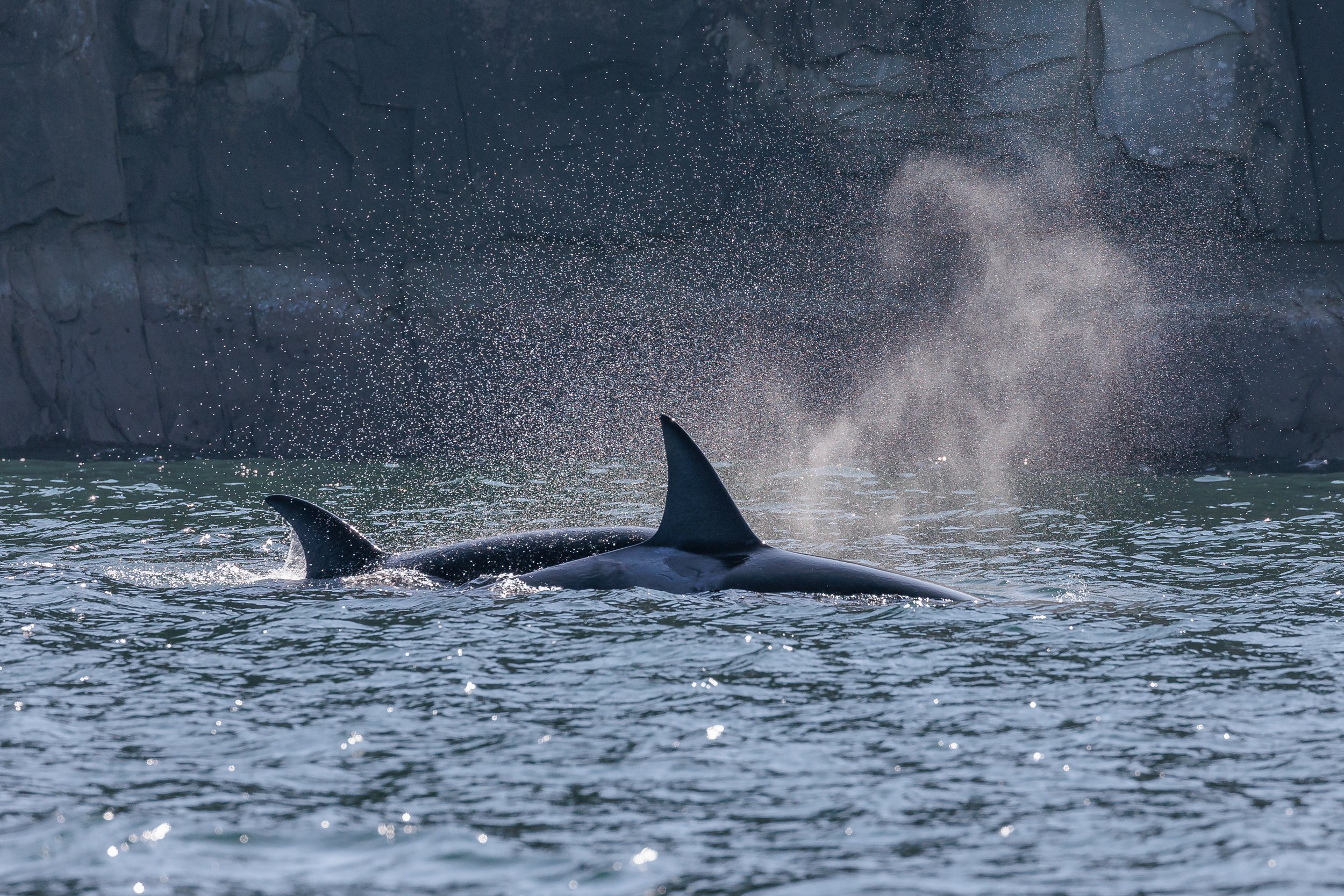September 5, 2023, 3:30 PM - The T075Bs and T077D Hunting Around Gabriola Island
There must have been something in the water today as all the whales we were seeing were doing all sorts of activity. We saw them hunting an unfortunate harbour seal and then they seemed to go into celebration mode! Between all the jumping out of the water, spy hopping, and tail slapping, we were able to get enough photos of the dorsal fins and saddle patches to get an ID on these whales, it was the T075Bs who were still travelling with T077D. That makes a total of 6 whales travelling together today:
T075B Pebbles ♀ (1995)
T075B2 Fifi / Jasper ♀ (2015)
T075B2A (2023)
T075B3 Rubble (2017)
T075B4 (2021)
T077D Alycon ♀ (2009)
While it was a great experience getting to see these whales seemingly so happy, there was a downside to this interaction that we would realize later. Looking back at our photos we saw that the young calf in the group, T075B2A was in very poor condition, and unfortunately, this was the last time we saw it with the rest of the pod.
Having a calf pass away although sad, isn’t uncommon, especially for a first-time mother. The mortality rate among orca is quite high, anywhere between about 40%-50% of orca calves don’t make it past the first year of life. There are a few things that can contribute to this high mortality rate such as toxins in the mother’s body being passed to the calf, food availability, and sometimes inexperience. Fifi/Jasper was a first-time mom with this calf, and at only 8 years old this is quite an early age to be having one. Typically, orca won’t have their first calf until they are in their early teens, although they reach sexual maturity much sooner than that. It’s the social aspect of things that usually causes orca to wait longer before having their first calf, as captive breeding programs have produced pregnancies much younger, as early as 6 years old.
With orca being such emotional and social creatures it doesn’t surprise us that there are social barriers to females reproducing the first time. Maybe this breaking of the social norm could’ve contributed to the fact that Fifi/Jasper wasn’t successful in raising this calf this time as family support usually plays a big role in the success of an orca.
Although this aspect of seeing this group was a sad realization after the fact, while we were watching them you wouldn’t suspect that anything was amiss, since they seemed as happy as can be.
We left them celebrating their hunt and continued on to other wildlife. We were lucky to see some massive Steller Sea Lions hanging out on Stinky Rocks, fighting among themselves. There was also some quieter Harbour Seals enjoying the sunshine on the rocks nearby. We left these animals to their rocks and took the inside of the Southern Gulf Islands back to Nanaimo. As we were heading into the Harbour, it seemed that the pod of orca wasn’t done with us yet as they made one more appearance! We got some really good looks at that little calf before we made our way back to the dock.
The onboard Marine Naturalist Vanessa Vereschahen captured some great photos of the T075Bs and T077D as well as the other wildlife, and you can view them all below. The photos including the calf are at the very end of the photos in case you don’t want to see them!
T077D Alycon surfacing in front of Gabriola Island. Photo by Vanessa Vereschahen.
T075B3 Rubble and T077D Alycon surfacing together. Photo by Vanessa Vereschahen.
T075B Pebbles surfacing with T077D Alycon. Photo by Vanessa Vereschahen.
T075B Pebbles diving behind T077D Alycon. Photo by Vanessa Vereschahen.
T077D Alycon surfacing in front of T075B3 Rubble. Photo by Vanessa Vereschahen.
T075B3 Rubble sticking their face out of the water! You can see their eye. Photo by Vanessa Vereschahen.
T075B4 surfacing. Photo by Vanessa Vereschahen.
T077D Alycon diving under the water. Photo by Vanessa Vereschahen.
T077D Alycon getting ready to slap her tail with another one right by her side. Photo by Vanessa Vereschahen.
Someone is sideways! Photo by Vanessa Vereschahen.
A beautiful tail flick! Photo by Vanessa Vereschahen.
T075B4 surfacing and showing off their eye patch. Photo by Vanessa Vereschahen.
Wow, T077D Alycon has so many fresh scratches! Photo by Vanessa Vereschahen.
T075B3 Rubble surfacing. Photo by Vanessa Vereschahen.
These two are likely T075B3 Rubble (left) and T075B4 (right). If this is the case, the mammary slits being present makes T075B4 a girl! Photo by Vanessa Vereschahen.
Another tail flick amongst the group of whales. Photo by Vanessa Vereschahen.
T075B2 Fifi / Jasper beside her sibling T075B3 Rubble. Photo by Vanessa Vereschahen.
T075B4 spy hopping beside T075B3 Rubble. Photo by Vanessa Vereschahen.
A backdive from T075B4.Photo by Vanessa Vereschahen.
T075B2 Fifi / Jasper traveling. Photo by Vanessa Vereschahen.
A happy little bob of Harbour seals. Photo by Vanessa Vereschahen.
Our Harbour seals can have a wide variety of coat colours, as seen here. Photo by Vanessa Vereschahen.
All of our ducks - er, Sea lions were in a row today. Photo by Vanessa Vereschahen.
Our large male Steller sea lions can often be seen scratching like dogs. Photo by Vanessa Vereschahen.
Look at that cute fuzzy face! Photo by Vanessa Vereschahen.
Nanaimo’s skyline at sunset. Photo by Vanessa Vereschahen.
Nanaimo’s skyline at sunset, with both Gabriola Island ferries (Island Kwigwis and Island Gwawis) visible. Photo by Vanessa Vereschahen.
A cormorant drying off on the Bluffs. Photo by Vanessa Vereschahen.
Gabriola Bluffs with many Cormorants up in the trees. Photo by Vanessa Vereschahen.
Matriarch T075B Pebbles with T075B3 Rubble and T075B2A ahead of her. Photo by Vanessa Vereschahen.
Little T075B2A in front of their aunt/uncle T075B3 Rubble. Photo by Vanessa Vereschahen.































